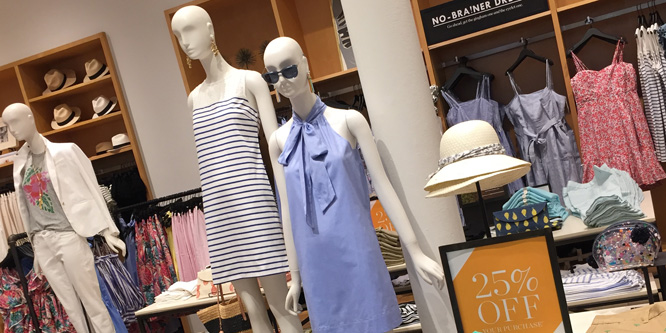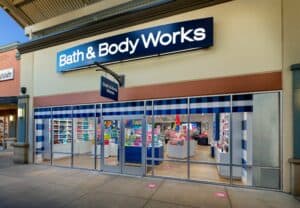
Photo: RetailWire
April 23, 2020
Getting back to business takes on a whole new meaning in the wake of COVID-19
When stores reopen — whenever that is — getting back to business will be both a welcome relief and a challenge for the executives in charge of keeping stores in stock with relevant merchandise.
Among the first issues they will have to deal with are empty racks and shelves. Many chose to cancel purchases when faced with extended store closures. The issues connected to this will also affect future seasons. A return to normalcy will not be instantaneous.
Retailers can forget simply trying to drive worried consumers to stores to spend their limited discretionary income. The key winter/spring months that would have been used to liquidate 2019 seasonal purchases are gone. Drastic markdowns will be needed. Those dollars generated will be crucial to paying for future inventory needs.
Forecasting is about to become a much more complicated process. It is true of the upcoming Christmas selling season as well as for the equivalent period next year matching with the current shutdown.
I would anticipate most if not all retailers will have an extremely conservative re-forecasted holiday sales plan. Their revenue has already been decimated for the first half of 2020, so their cash flow will not allow for anything else. It’s likely that 2020 holiday comp sales will have the largest decline in recent memory. The same ultra-conservative sales plan will almost certainly bleed over into the first half of next year.
One of the new, new normal processes that we will likely see is retailers shortening the time to market from concept to consumer. This will mitigate some of the negative effects of not having historical data for the months that stores remain closed.
Shortening the process will enable retailers to react more quickly to sudden changes. And this applies to the entire product lifecycle management. It should enable faster design, prototyping and approval, more diversified geographical location of manufacturing, and result in more reliance on faster albeit more expensive shipping methods.
Jack Feinstein, a merchandise planning and inventory management expert, and Robin Issacsohn, a consultant specializing in merchandise planning, business analytics, and inventory management infrastructure, contributed to this article.
Discussion Questions
DISCUSSION QUESTIONS: How do you expect retailers to mitigate some of the negative impacts of not having historical data for the months that stores have been closed? How effective do you expect most retailers to be in reducing the time to market from concept to consumer?
Poll
BrainTrust
Cathy Hotka
Principal, Cathy Hotka & Associates
Peter Charness
Retail Strategy - UST Global
Ken Morris
Managing Partner Cambridge Retail Advisors
Recent Discussions







I can’t forecast the fall season (other than to agree that stores need to be very conservative in their sales planning and risk-averse in their assortment planning.) But in the short term, cash flow is critical for most stores whose doors have been closed. The normal approach is to be very aggressive on clearance pricing (80 percent off should get shoppers’ attention), but the risk of “too much traffic” is a second spike in COVID-19 cases. Stores will simply have to be sure they have the right safety protocols in place, and these can be tested market-by-market depending on which regions of the country can reopen first.
Reopening stores will be a significant challenge. For instance: 1.) What happens to the inventory that for many stores is no longer needed, such as apparel? 2.) What employees do retailers bring back, and will they have customers to support rehiring store associates? 3.) Will customers shop, or will they be afraid to enter stores?
The list goes on. I would expect that retailers will take it slowly and in stages. Most likely, we’ll see a chain such as Kohl’s or Macy’s open stores geographically starting with a few states and then gradually increasing until all stores are open. We will no doubt see huge sales and markdowns to get rid of the inventory now, not needed, and it will be a challenge for retailers to get their new inventory in the stores, especially if they continue with a limited staff. All this said means that no matter what course of action any retailer takes, they are going to have their hands full with challenges and issues they have never seen before.
Retailers need to utilize a fine balance of intuition and data science. They need to evaluate each product category, and evaluate for relevance post-COVID-19. If the retailer has multiple channels, the online portion will give some indications. Macro-economic indicators in the zip codes in which they are operating need to be factored in.
The analysis and intuition should be based on a combination of their own data, syndicated data from the likes of Nielsen, customer surveys to assess mood and demand, and macro analysis.
Any business putting in critical thought and structured analysis will do better than rest.
There are a number of great points here. The bottom line is that 2020 is going to be an inventory disaster. Apparel stores will re-open with sweaters and other early spring merchandise, and I doubt that cash-strapped Americans will be clamoring for new bathing suits for that vacation they won’t be taking. This whole year is going to be an asterisk.
“…and yours, dear Cathy, was the funniest cut of all.” (Paraphrased from Julius Caesar.)
While this crisis has crippled the fashion world, my hope is that — for the retailers and brands that will survive — designers and merchants will take this time to offer the customer something new and exciting that they haven’t seen before. This is the opportunity to get out of the cycle of staleness and sameness that has hurt the industry for the past several years.
2021 will be a new baseline for at least the first half of that year. Mathematical extrapolation can only be of very limited use for demand forecasting in this situation. I think we all need to look at our own specific circumstances location by location, and plan based upon the local restrictions, current inventory, incoming product, balance sheet, etc.
I agree with most every comment here. The one thing I see coming is a tidal wave of requests (perhaps demands) for dating on the balance of the year’s receipts, and multiple orders written with strict, staggered delivery dates which will be subject to cancellations if not shipped as stipulated. Either way, it will be painful for most of the retail industry.
It’s a whole new world of forecasting. We are probably looking at an upcoming two years of retail life where current trend and LY information will not be able to be used like they have historically been utilized. Too many moving parts changing plus and minus on an on-going basis. That means leveraging out of risk and into condensed calendars. Supply chain management takes on a whole new level of importance.
There’s going to be a whole lot of clearing going on. Stores could consider being format flexible. Perhaps for the first few months everyone needs to have a higher percentage of their stores looking a lot like outlets, both to clear inventory and to entice shoppers As the glut of old stock sells down, then the store mix between “brand stores” and “outlet look” can change. While this kind of flexibility isn’t baked into the retail psyche (a store is either a brand store or an outlet store and doesn’t switch dynamically) extraordinary times call for innovative use of the locations that retailers have.
That’s a really great point.
Pretty much none of the historical data and inventory forecasting software will be able to handle this year when stores reopen. Supply chain and consumer behavior is significantly changed. When luxury stores reopened in China there was a rush of binge shopping which is unusual. I think all retailers can do is be authentic, and ask customers to be considerate when they reopen the stores in terms of inventory availability and store hours.
Retailers will need to place more emphasis on two and three year old data to replace the lost season we are in. It will be similar to how they plan new stores today that have no history. They can create a pro-forma model for the missing season by leveraging movement for year 2 and 3 by store.
Reducing time to market is a greater challenge but one that needs to start now. Just like in 9/11 when sourcing in Pakistan was negatively affected the soft goods supply chain we need to find alternative sourcing on or near shore as quickly as possible to compress the timeline from concept to consumer.
It is hard to imagine for most of us what life will be like post COVID-19. Will there be a second wave in fall 2020? Will there be a vaccine next year? Will there ever be a vaccine? A long list of “ifs” for retailers to navigate. A great deal of waste and pollution has been associated with the apparel industry. Burning of clothes, toxic dyes seeping into the environment, retailers who have merchandised themselves into irrelevance, stores merchandised nationally rather than locally.
Then BAM! … everything changes in 8 weeks for suppliers, brands, manufacturers, retailers, and retail associates. I believe historical data is just that, historical. Retail has been on a path of excess for years propped up by reliance on data versus retail talent. Data-driven algorithms will not be able to tell retailers what to do now in COVID times. Retailers to survive must reinvent top to bottom. It will take more than reducing the time to market from concept to consumer. COVID has changed everything. There will be a lot of commotion and human emotion as retailers struggle through this time.
Enter the post-COVID generation of great retail minds, supply chain leaders, relevant brands, and eco-manufacturers.
I don’t, and they won’t. No one “knows” what’s gong to happen … everyone is going to guess; some of those guesses will turn out correct or close to it, either through luck or because the underlying thinking was better.
Improving processes would be great for the obvious reason that efficiency/cost control will be more important than ever, but with everything disrupted, companies will be lucky to achieve pre-crisis performance.
Retailers should recognize that we are nowhere near getting ready. Until we are embracing full testing of everyone and have a vaccine to use, getting back to business only allows for the increase of COVID-19.